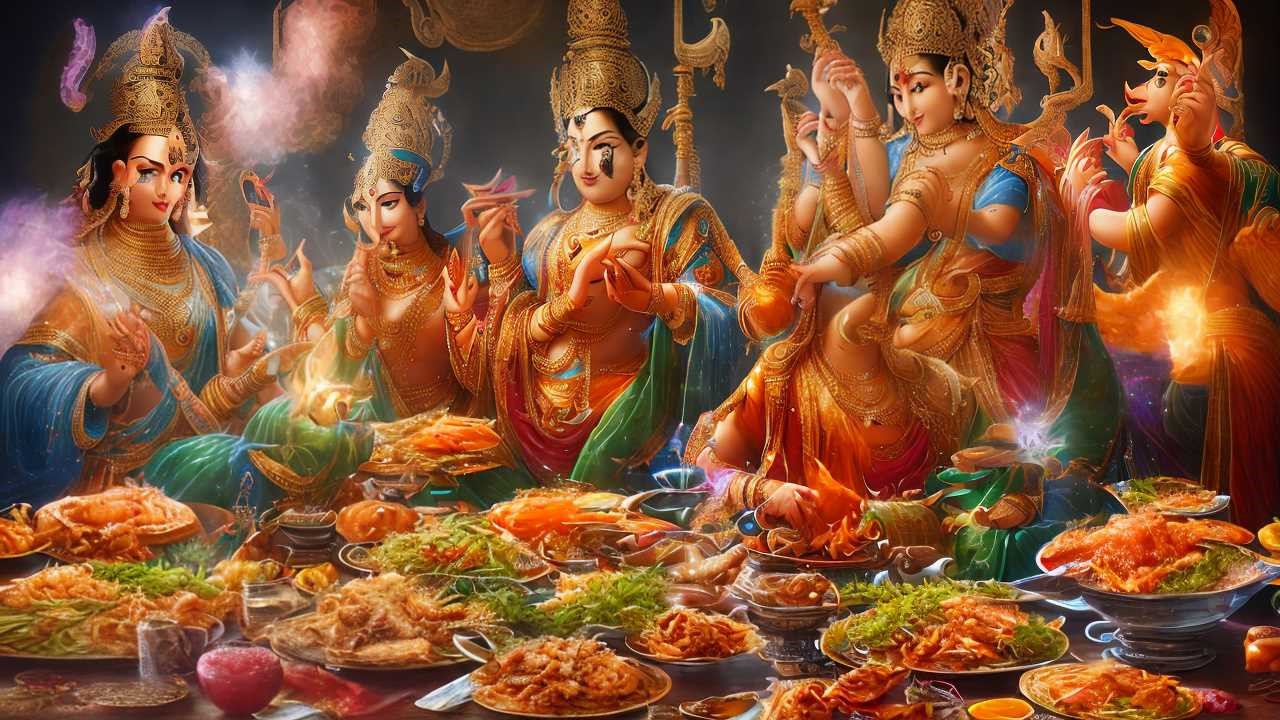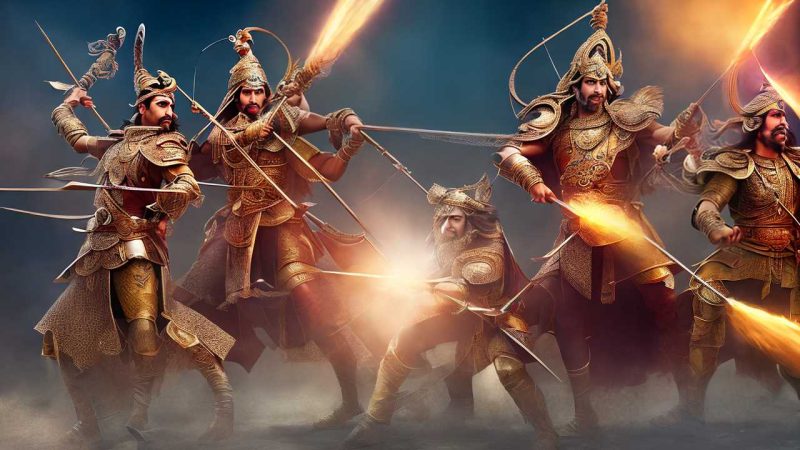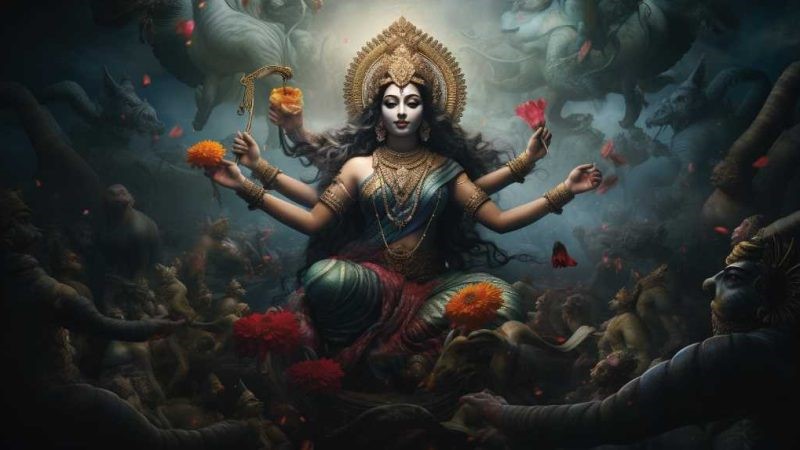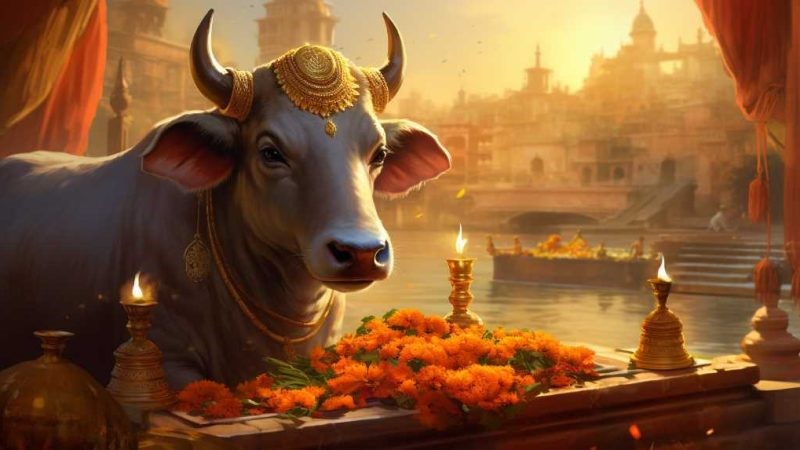Dietary Diversities Non-Vegetarian Hindu Gods

In Hinduism, many people think of followers as vegetarians because they believe in not harming others, but it’s interesting to see that some Hindu gods actually have diets that include meat. For example, the warrior goddess Kali is known to have animal offerings given to her, and the god Shiva is sometimes shown eating wild animals, showing a different side of his personality. This shows us that Hinduism takes in different traditions and histories into its beliefs. Understanding what gods eat can give us insight into Hindu traditions and what they mean, as well as the variety of rules about food that exist in the religion.
Kali’s Predilection for Flesh
In Hinduism, Goddess Kali is unique because she is linked to eating meat, which is unusual in Hindu beliefs. This aspect of Kali is not just about food; it teaches us about letting go of our personal desires and remembering that everything in the universe, including life and death, is connected and keeps changing.
Kali is often shown with a necklace of heads and a belt of arms, which reminds us of ancient religious practices where meat was part of the rituals. These rituals were different from the usual Hindu ways of eating. Experts think Kali’s love for meat and her fierce look are ways she deals with bad energies. Kali eating meat is really about showing how she can change things in the world.
Let’s talk about why this matters. Kali’s connection to meat is a way for people to understand deeper truths about the world. It’s like she’s showing us how to embrace change and deal with the tough parts of life. By doing so, Kali teaches us an important lesson about growth and transformation.
When we look at Kali, we see a Goddess who doesn’t just follow the usual rules. Instead, she invites us to think about the big picture and the role we all play in it. Her story reminds us that even things that seem scary or different can have a special meaning and help us grow.
The Hunter God, Shiva
Shiva is a key figure in Hinduism and is unique because he represents two opposite things: being a peaceful yogi and a fierce hunter. This mix shows how he’s involved in both creating things and taking them away, which helps the world stay fresh and alive. He’s also known as the Lord of the Animals, Pashupati, which connects him to wild creatures and the forces of nature.
In some stories, like the one about Kirata, Shiva becomes a hunter to test the hero Arjuna. This shows that Shiva’s character is complex; he’s not just about peace and calm, but also about the harsher sides of life, like hunting for food. This view of Shiva makes us rethink the idea that all Hindu gods are shown as vegetarians. It shows the rich variety in how gods are seen and how they fit into the natural world’s cycles and maintaining the balance of life.
To better understand Shiva’s role, let’s take a closer look at the Kirata story. In this tale, Shiva disguises himself as a common forest hunter to check if Arjuna, a great warrior, is worthy. It’s an exciting story that teaches us about humility and the importance of being tested to prove our worth. By seeing Shiva in this light, we can appreciate the diversity in the stories of Hindu gods and the lessons they offer.
Goddess Saraswati’s Aquatic Delicacies
When we look at Goddess Saraswati, we find a goddess who is fond of eating seafood. This is interesting because it connects her with water, which is important for life and knowledge, two things she is known for. Eating fish and other seafood is a way to show how we can feed our minds and our creativity, just like water helps life grow.
This is something people talk about a lot when they discuss what Hindu gods eat because it’s different from the usual vegetarian food given to them. This shows us that there is more to the gods than we might think, and it reminds us that all kinds of life are important for learning and living.
For example, offering fish to Saraswati during a worship ceremony can be seen as a way to ask for her blessings on our learning and artistic projects. It’s like saying we understand that both the spiritual and physical parts of our world are connected, and we respect that.
This way of thinking about the gods makes our relationship with them and the world around us richer and more meaningful.
The Avatar Parashurama’s Warrior Diet
What kind of food would the mighty Avatar Parashurama eat to stay strong? Parashurama is a hero from Hindu stories who is part of Lord Vishnu. He’s known as a strong fighter and a teacher. His food would likely be full of things that are good for health and keep the mind sharp.
Even though we don’t have exact details from old texts, we can guess that he would eat what warriors of his class, the Kshatriya, ate. This includes lots of protein, and maybe meat, to give him energy and help him stay strong for battles and hard work. Eating this way makes sense for someone like Parashurama because it fits with his image as a tough and skilled fighter in these stories.
When we think about Parashurama’s food, it’s not just about eating to be full. It’s about choosing foods that help him be the best warrior he can be. This shows us that being disciplined in what you eat is part of being a great fighter in these ancient tales.
Bhairava and Ritualistic Consumption
Bhairava is a scary form of Lord Shiva, and his worship is unique because it sometimes involves eating meat and drinking alcohol. This is different from the usual Hindu practice of being vegetarian. The reason Bhairava worship includes these things is that Bhairava is seen as the one who gets rid of fear and looks after those on the edges of society, where the usual rules might not apply. When followers eat meat and drink alcohol in his honor, it’s not just for fun. It symbolizes getting rid of bad habits and taking in Bhairava’s powerful energy. Experts in this field think that these actions have a deeper meaning. They are about changing oneself and going beyond usual limits, which is an important part of the spiritual practices that honor Bhairava.
This worship tradition is about more than just eating and drinking; it’s a spiritual journey. For example, when a follower offers alcohol to Bhairava, it’s not just sharing a drink. It’s an act that shows they want to overcome their own limitations and connect with the divine. This connection to Bhairava helps them to face and destroy their fears.
In short, the way Bhairava is worshiped, with meat and alcohol, is a powerful symbol of personal transformation and facing fears head-on. It’s a tradition that’s deep with meaning and an important part of the spiritual lives of those who practice it.
Conclusion
In the stories about Hindu gods, we can see that they have different food preferences. These choices are not just about what they eat but also have deeper meanings connected to their roles in religion and society.
For example, gods like Kali and Bhairava sometimes eat meat, which shows their fierce and powerful nature. Shiva, on the other hand, is often associated with simpler, more ascetic living, and Saraswati is connected with wisdom and learning, which might suggest a more pure or vegetarian diet. Parashurama is a warrior and his diet could be seen as functional for his active role.
These examples show us how Hinduism is open to different ways of living, even among the gods.
When we look at these gods’ eating habits, it’s not just about the food. It’s about what the food represents. Kali’s meat-eating can be a symbol of her power over life and death. Shiva’s simple diet can remind us of the value of living with less.
By learning about these gods and what they eat, we get a better understanding of Hindu values and beliefs. Hinduism teaches that there are many different but equally valid ways to live and worship, which is reflected in the diverse diets of its gods.
This is a great example of how variety is embraced in Hindu culture, both in heaven and on earth.






